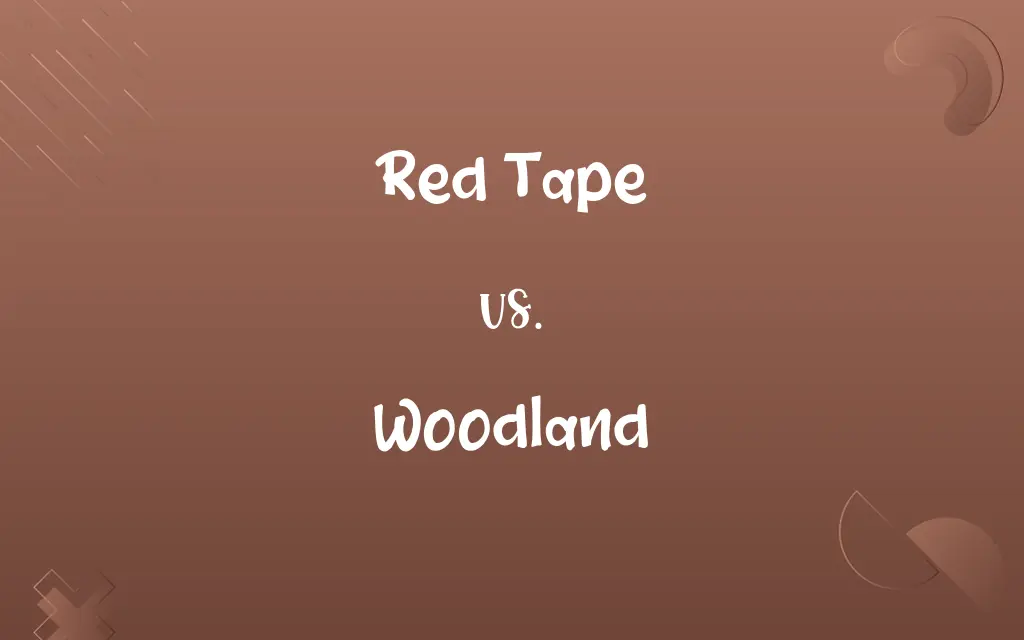Red Tape vs. Woodland: Know the Difference

By Shumaila Saeed || Published on February 12, 2024
"Red Tape" refers to excessive bureaucracy or adherence to rules and formalities, while "Woodland" describes an area covered with trees and undergrowth.

Key Differences
Red Tape symbolizes the complex procedures and forms often required by bureaucratic systems, leading to delays and frustration. It typically involves an overabundance of paperwork and regulations. In contrast, Woodland refers to an area dense with trees, shrubs, and natural vegetation, offering a habitat for wildlife and a space for ecological balance.
Shumaila Saeed
Feb 12, 2024
The term Red Tape originates from the historical practice of binding official documents with red tape. It has evolved to represent the slow and complicated processes in government and organizations. Woodland, on the other hand, describes a natural environment, varying in size from small woods to extensive forest areas, often used for conservation, recreation, and as a resource for timber.
Shumaila Saeed
Feb 12, 2024
Red Tape is often criticized for creating inefficiencies and hindering progress in administrative matters. It is a term used globally to denote unnecessary complexity in organizational processes. Woodland represents a critical component of the earth's ecosystem, playing a vital role in maintaining biodiversity, climate regulation, and providing resources for human use.
Shumaila Saeed
Feb 12, 2024
In dealing with Red Tape, individuals and businesses may experience increased costs and time consumption due to stringent compliance requirements. Woodland environments, conversely, are essential for ecological health, offering benefits like air purification, carbon sequestration, and soil conservation.
Shumaila Saeed
Feb 12, 2024
Red Tape can affect various sectors, including government services, legal processes, and corporate operations, often leading to calls for reform and simplification. Woodland areas are subject to environmental policies and conservation efforts, reflecting the importance of preserving natural habitats for sustainability and biodiversity.
Shumaila Saeed
Feb 12, 2024
ADVERTISEMENT
Comparison Chart
Definition
Excessive bureaucracy and formalities.
An area covered with trees and undergrowth.
Shumaila Saeed
Feb 12, 2024
Origin
Symbolic of binding official documents with red tape.
Derived from natural wooded environments.
Shumaila Saeed
Feb 12, 2024
Purpose/Role
Often seen as hindering efficiency in processes.
Provides habitat, maintains biodiversity, ecological balance.
Shumaila Saeed
Feb 12, 2024
Impact on Activities
Creates delays and increases costs in administrative tasks.
Offers benefits like recreation, resources, and ecosystem services.
Shumaila Saeed
Feb 12, 2024
Relation to Environment
Pertains to organizational and bureaucratic settings.
Integral part of the natural environment and ecology.
Shumaila Saeed
Feb 12, 2024
ADVERTISEMENT
Red Tape and Woodland Definitions
Red Tape
Administrative Barriers
Entrepreneurs often complain about red tape stifling innovation.
Shumaila Saeed
Jan 19, 2024
Red Tape
Bureaucratic Procedures
The project was delayed due to red tape in obtaining permits.
Shumaila Saeed
Jan 19, 2024
Woodland
Recreational Space
The woodland offers beautiful trails for walkers.
Shumaila Saeed
Jan 19, 2024
Red Tape
Regulatory Complexities
Navigating the red tape of tax laws can be challenging.
Shumaila Saeed
Jan 19, 2024
ADVERTISEMENT
Red Tape
Excessive Formalities
Red tape in the application process can be discouraging.
Shumaila Saeed
Jan 19, 2024
Red Tape
Governmental Paperwork
Cutting red tape is essential for faster public service delivery.
Shumaila Saeed
Jan 19, 2024
Woodland
Ecological Zone
This woodland plays a key role in the local ecosystem.
Shumaila Saeed
Jan 19, 2024
Woodland
Of or relating to a Native American culture prevalent throughout much of eastern North America beginning around 1000 BC and lasting especially in northeastern regions until contact with Europeans, characterized by increasing reliance on settled agriculture, by the development of Neolithic crafts and tools, and in certain areas by the building of ceremonial mounds.
Shumaila Saeed
Jan 18, 2024
Woodland
Of a creature or object: growing, living, or existing in a woodland.
The woodland creatures ran from the fire.
Shumaila Saeed
Jan 18, 2024
Woodland
Land covered with wood or trees; forest; land on which trees are allowed to grow, either for fuel or timber.
Here hills and vales, the woodland and the plain,Here earth and water seem to strive again.
Woodlands and cultivated fields are harmoniously blended.
Shumaila Saeed
Jan 18, 2024
Woodland
Of or pertaining to woods or woodland; living in the forest; sylvan.
She had a rustic, woodland air.
Like summer breeze by woodland stream.
Shumaila Saeed
Jan 18, 2024
Repeatedly Asked Queries
What is a woodland?
A woodland is an area covered predominantly with trees and undergrowth.
Shumaila Saeed
Feb 12, 2024
Can woodlands be found in urban areas?
Yes, woodlands can exist as small forested areas in or near urban settings.
Shumaila Saeed
Feb 12, 2024
Is red tape always negative?
Red tape is often viewed negatively due to its association with inefficiency.
Shumaila Saeed
Feb 12, 2024
What causes red tape?
Complex regulations and a focus on procedural details often cause red tape.
Shumaila Saeed
Feb 12, 2024
What does red tape mean?
Red tape refers to excessive bureaucratic procedures and formalities.
Shumaila Saeed
Feb 12, 2024
Is red tape a modern phenomenon?
The concept of red tape has been around for centuries, though it has evolved.
Shumaila Saeed
Feb 12, 2024
What wildlife lives in woodlands?
Woodlands host a variety of wildlife, including birds, mammals, and insects.
Shumaila Saeed
Feb 12, 2024
What sectors are most affected by red tape?
Government, legal, and healthcare sectors often deal with significant red tape.
Shumaila Saeed
Feb 12, 2024
Can red tape be completely eliminated?
While difficult to eliminate entirely, red tape can be significantly reduced.
Shumaila Saeed
Feb 12, 2024
What are the challenges in dealing with red tape?
Complexity, time consumption, and increased costs are common challenges.
Shumaila Saeed
Feb 12, 2024
Can woodlands be created artificially?
Yes, woodlands can be created through afforestation and conservation efforts.
Shumaila Saeed
Feb 12, 2024
Do woodlands play a role in local cultures?
Yes, woodlands often have cultural, historical, and recreational significance.
Shumaila Saeed
Feb 12, 2024
What is the importance of woodlands?
Woodlands are important for biodiversity, climate regulation, and recreation.
Shumaila Saeed
Feb 12, 2024
How can red tape be reduced?
Streamlining processes and simplifying regulations can help reduce red tape.
Shumaila Saeed
Feb 12, 2024
Do woodlands differ from forests?
Yes, woodlands are generally smaller and less dense than forests.
Shumaila Saeed
Feb 12, 2024
Does red tape affect all businesses?
Red tape can impact businesses of all sizes, often varying by industry.
Shumaila Saeed
Feb 12, 2024
Are woodlands protected by law?
Many woodlands are protected under environmental and conservation laws.
Shumaila Saeed
Feb 12, 2024
How are woodlands managed?
Woodlands are managed through conservation efforts and sustainable practices.
Shumaila Saeed
Feb 12, 2024
Are there benefits to red tape?
In some cases, red tape ensures thoroughness and adherence to standards.
Shumaila Saeed
Feb 12, 2024
How do woodlands affect the environment?
Woodlands contribute to air and water purification, carbon storage, and soil conservation.
Shumaila Saeed
Feb 12, 2024
Share this page
Link for your blog / website
HTML
Link to share via messenger
About Author
Written by
Shumaila SaeedShumaila Saeed, an expert content creator with 6 years of experience, specializes in distilling complex topics into easily digestible comparisons, shining a light on the nuances that both inform and educate readers with clarity and accuracy.








































































